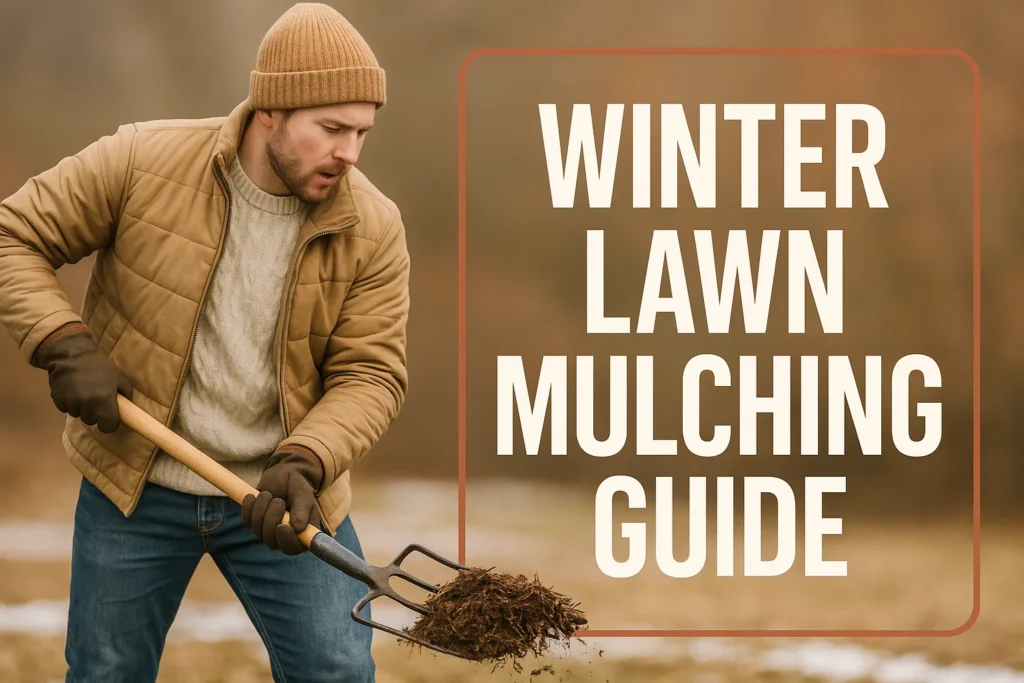Lawns are hard in winter. When the lawn is not properly covered, it may get damaged during cold weather and frost. Mulching is an easy and efficient method of making your lawn survive the winter months. With the layer of mulch you add, the soil is kept warmer and the soil can retain moisture. This facilitates the ease with which the grass roots remain healthy despite the freezing temperatures and dry winter days.
This guide will learn you how to mulch your lawn in the winter. It includes selecting the appropriate material, the thickness of the mulch, as well as advice on how to keep your lawn safe in cold weather.
The Importance of Mulching Your Lawn for Winter
Winter mulching of your lawn is a very necessary measure to keep it from cold damage. The thick layer of mulch serves the function of a blanket to keep the soil at a constant temperature and also to protect the grass roots during severe freeze-thaw cycles. This avoids the destruction of roots and also helps your lawn to survive during the cold season.
Mulch also keeps water in the soil by minimizing evaporation, thus keeping roots moist where watering is not necessary. It also stops erosion of the soil when subjected to rain and melting snow, and this saves you the precious topsoil around your grass.
Also, mulching prevents the growth of winter weeds by preventing access to sunlight. The breakdown of organic mulch replenishes the soil with nutrients and promotes healthy growth in the spring.
Best Types of Mulch for Winter Protection
When it comes to winter, it is essential to have a proper mulch covering your lawn. The following are the best winter-protecting mulch types:
1. Straw or Hay Mulch
Winter mulching is an excellent option with straw or hay. It offers good insulation to the soil and the grass roots are not destroyed by frost. Straw is better than hay because it has few seeds which may grow as weeds. It decomposes rather rapidly and enriches the soil with organic material, though you might have to apply it annually.
2. Shredded Leaves
Leaves torn into shreds form recycled and economical compost. They are good insulators and also suppress weeds. When they fall, torn leaves enhance the soil structure and provide nutrients back into the soil, making it richer in spring.
3. Pine Straw
Pine straw is a light mulch that is not easy to compact. It is well insulated and it is appealing to lawns and garden beds. Pine straw is particularly suitable for acid-loving plants but can be used to provide overall winter cover to lawns.
4. Wood Chips and Bark
Shredded bark and coarse wood chips are long lasting mulches that decompose slowly. They offer protection of roots and leave air to circulate. They can be used at the base of trees and shrubs, but also can be applied to areas of lawn in the winter.
5. Compost
Well-rotted compost is a good universal mulch. It enhances soil fertility, increases the activities of the microbes and aids in the regulation of soil temperature. Compost decomposes fast and it provides nutrients that nourish healthy grasses during spring.
How and When to Apply Mulch for Winter

It is necessary to apply the mulch properly and on time to save your lawn over winter. When to apply the mulch: It should be applied immediately after the first hard frost, though before the ground is solid. During this time, the mulch provides the soil with moisture and maintains a stable temperature when the cold intensifies.
Preparation: Make sure that you prepare your lawn in advance before the application of mulch. Clean up leaves, dead grass and debris to have a clean surface. When the soil is dry, water it slightly in order to ensure that the mulch is able to retain water.
Lay it on the Mulch: The thickness of the mulch should be 2 to 4 inches when applied. An excessively thin layer will provide insufficient protection, whereas excessive thickness will suffocate your grass or create other problems, such as molds. It is not advisable to stack the mulch right on top of grass blades and stems of plants as this will cause rot.
During winter, inspect your mulch frequently. It may be compacted or moved due to wind, rain or snow. Turn over the mulch or add to maintain a smooth protective layer.
Common Mistakes to Avoid When Mulching for Winter
| Mistake | Description | How to Avoid |
| Mulching Too Thick | Can suffocate roots and cause rot | Apply 2 to 4 inches only |
| Wrong Mulch Type | May harm plants or soil | Choose mulch suited for your plants |
| Mulch Against Stems | Traps moisture and causes decay | Leave 2-3 inch gap around stems |
| Mulching Over Weeds | Weeds grow through mulch | Remove weeds before mulching |
| Using Fresh Wood Chips | Depletes soil nitrogen | Use aged or composted wood chips |
| Wrong Timing | Mulching too early or late harms plants | Mulch after first frost, before freeze |
| Not Watering | Dry soil and mulch reduce effectiveness | Water before and after mulching |
| Poor Mulch Quality | May contain pests or chemicals | Buy high-quality, clean mulch |
Conclusion
The correct time and method of mulching your lawn in winter can save your lawn from the untamed weather and prepare your yard to have a healthy spring. You can prevent the most common mistakes such as choosing the incorrect sort of mulch or putting too much on your lawn, to make sure that your lawn receives the appropriate treatment. To do professional winter mulching and all year-round lawn care, rely on Revamping Lawn LLC. Our team offers quality service to help you maintain a strong and beautiful lawn all year round. Today, call us to make your lawn proud.
FAQ’s
In the first hard frost, before the ground is frozen.
About 2 to 4 inches is ideal.
Straw, shredded leaves, pine straw, wood chips or compost are the most effective organic mulches.
No, leave a little space open to avoid rot and pest problems.
Check during winter and fluff or add more when compressed or moves.



